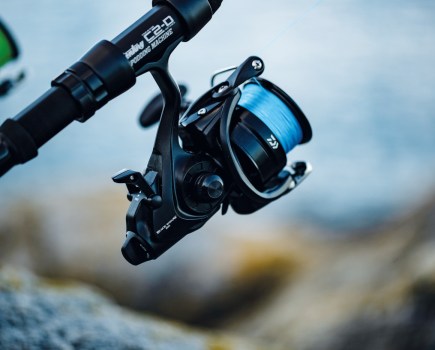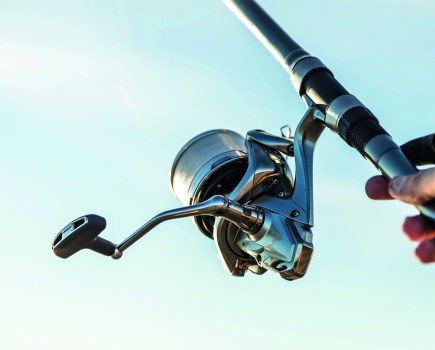Fishing open beaches where distance is often the key, I have long standardised on 6500CT-type multipliers, sticking with them because there was nothing better for long range work.
Their saving grace is that they cast supremely well, but as practical fishing tools most of them are limited in capacity, retrieve power and durability. Adequate for clean ground, they crash and burn in the rough stuff.
New reels arrived that seem to answer my prayers, but they never quite measured up. First, in the 1980s, came the Shimano Speedmaster, so hyped by the media that it almost achieved legendary status before it hit the shops. It would smash all tournament records, the pundits claimed
I phoned a friend in Wales. He knew somebody who knew somebody who had a pal in the trade… yes, the Speedmaster really was awesome. Eventually, I got hold of one, and indeed it was awesome. Awesomely willful and spiteful to cast, heavy and awkward. I want a multiplier that casts like a 6500CT but is tough as tungsten, friendly and compact.
THE CONTENDERS – BUT ARE THEY ANY GOOD?
Two more contenders turned up recently. The Penn Fathom II Casting Special and the Akios Nitron F-15. Are they any good? Clicking my way through the jungle of woeful ignorance called social media landed me in forums where both reels were being dissected. I had hoped to extract solid information from wise owls. I got starlings. Squabbling amongst themselves, the flock pecked away, the inevitable result being a digital version of what real starlings leave behind in my garden. The few sensible and thoughtful views lay half-buried in the mess, but for the most part, I learned nothing of value. Little wonder, for hardly anyone, had actually tried or even seen either reel.
By chance, or maybe by divine intervention, both turned up for Sea Angler to review. It would take at least a season to get to the guts of it, but I am already confident that my quest for a 6500CT-type reel replacement has ended.
If Akios’s aim was to produce a reel with the casting finesse of a 6500CT in a rugged and thoroughly practical beach multiplier, then they have nailed it. Being a child of the well-established Fathom family, the Casting Special seems more evolution than revolution, as if somebody at Penn had spotted an opportunity to widen the appeal. If so, the company has succeeded to similarly high standards but in a slightly different direction from Akios.
In the hands of maybe a dozen tournament casters, the F-15 should be right up there with the respected 6500CT-type reels. Design alone means that the Penn will inevitably lag by a quite a few metres. Will top casters put in the time and effort to extract the very best from them? Only a reel of exceptional promise will lure them away from their customised CTs.
The jury will be out for some considerable time before the picture becomes clear. In the greater scheme of things, none of this hyper-performance stuff really matters. Fishing is what really counts.
When it comes to distance, no reel is better than its owner. Except for a small elite, few anglers can put a baited rig more than about 125 metres out to sea. This is the performance ballpark I focus on when reviewing beach rods and reels.
Having tested this pair at distances longer and shorter, in good weather and bad, and with a range of rods and sinkers, I find that the Nitron and the Fathom cast as far and as easily as I shall ever need. Far more important, they are excellent and versatile fishing tools, easy to tune and control. They are more robust than small CTs, have superior drags and effortless retrieve even under high line tension. For a very reasonable £200 or thereabouts (RRP: Akios F-15 £229.95, Fathom CS £195.99) they slot beautifully into the gap in my beach armoury. But which one to choose?
TECHNICAL OVERVIEW – WHAT YOU GET
The Fathom and the F-15 cradle their spools with frame, sideplates, handles, gearing and cast control essential for creating a sophisticated yet tough multiplier reel. They have much in common: one-piece frames, gearing of about 6:1, cosy grips and handles designed to make retrieve a relaxed business. There’s a magnetic brake, spool end float control and a loudish ratchet, as well as decent bearings in spots where decent bearings ought to be.
The Penn is hewn from solid metal while the Akios takes a more Space Age route with moulded composites. The all-black Penn’s finish is billed as “stealth”; the Akios’s carbon-weave is actually a hydrodipping job and none the worse for that, especially seen alongside the smart red handle and drag star wheel.
The Fathom includes Penn’s respected Versa-Drag with HT100 discs and the Akios unit is a multi-disc carbon affair. Each is progressive and smooth with an excellent span of pressures. Handles swing through a bigger arc than on 6500-size reels, giving the mechanical advantage appropriate for high gearing and heavy loads.
Frames are spot-on, rigid and accurate. The Penn’s frame holds the spool high enough not to foul the leader when the spool is topped right up with mainline, yet low enough for your thumb to wrap around for secure casting. The Akios is lower slung but still with sufficient line clearance at the bottom of the frame. Reel attachment saddles are metal, securely riveted and accurately aligned.
Featuring main gears of marine bronze meshing with a stainless-steel pinion (Penn), or milled from brass with a bronze pinion (Akios), the engineering of these reels lays a solid foundation for performance, reliability and long life. There are bound to be a few long-term niggles, but simple care and maintenance should keep them healthy for years.
x-head: The Spools
The pair benefit from machined alloy spools on rugged static spindles. They are as refined as anything this side of a custom reel. Almost regardless of distance and load, they run creamy-smooth with a muted hum. Bearings sit securely and precisely in pockets machined into the spool ends. The retractable drive pinion – a quantum leap in toughness from the flimsy link on so many reels – slots into a castellated circlip, which also secures the right-hand spool bearing. A plastic ratchet cog caps the left bearing.
Factory bearings are excellent. Wipe away the excess grease, add a drop of Rocket Fuel or even 3-in-1, and these reels are good to go. I have rarely upgraded or replaced the bearings on any of my reels, and these would be no exception.
Spool end float is controlled by an adjustment cap near the drag’s star wheel. Neither reel has a second cap on the opposite side plate, meaning that spool centring could potentially be a pain. Just a millimetre or two off centre can cause problems because it usually opens a gap between spool flanges and frame leading to the line being trapped or even snapped. According to some of the starlings, both reels suffer.
My test Penn’s centring is exact. The F-15 spool is offset by about 1mm, which is acceptable and perhaps explained by the reel’s being a pre-production sample. At no time during my tests, field or beach, did either reel trap line regardless of diameter. All the same, two adjustment caps would counteract the inevitable small differences between individual reels, especially when it comes to fitting spare spools.
Why on earth no quick-change spool facility? Crack-offs, snagging and routine maintenance mean that a beach angler needs fast, easy spool and bearing access through the left sideplate. The Penn’s tiny screws are an awkward nuisance. The F-15’s are as bad. Now factor in dropped screws disappearing into the shingle. At the very least, both reels deserve a system such as Abu’s captive screws with knurled caps. Low marks here, I’m afraid.
x-head: Spool capacity
Unloaded, the spools appear to be of similar capacity. They are not. The capacity of the Akios is close to my Daiwa 7HT’s, which in turn is typical of most 6500-size reels. To confirm that, I transferred line from the 7HT to the Nitron F-15. The level was just about perfect. Little wonder that it casts like a regular small CT, thus living up to Akios’s promise.
A fully loaded Fathom Casting Special actually enjoys a 30 per cent capacity advantage over a fully loaded Nitron F-15. The manufacturer’s figures for 15lb monofil are roughly 395m and 275m respectively. This isn’t necessarily a good working comparison, for few reels and even fewer anglers do well with spools crammed to bursting.
Line level needs to be kept down a bit for decent control, the rough rule being that the thinner the line, the lower the safe level becomes. With 0.35mm, a the Nitron’s working level for most beach anglers will be about 2mm down from the spool lip against 3-4mm on the Penn. Even here both reels hold more than enough line for fishing.
The rule also works in reverse: the thicker the line, the higher you can safely load a spool. I had no trouble using the Fathom Casting Special crammed to the gills with 0.45mm monofil. Line level drops so quickly that just a bit of magnet power keeps the cast intact. Loaded to its limit with the same stuff, the Akios sails out… but runs out. It doesn’t hold enough to be a practical option for me, but your mileage might vary. Even on 0.40mm line, the Akios’s capacity is likely to be marginal for distance work. Filled even modestly high, the Fathom swallows masses.
This difference in line capacity may be a make or break issue. Depending on the line you like and the distance to be cast, the choice between the two reels may even make itself. Braid colours that decision to a degree because few anglers are likely to need anything above 0.30mm, which is about 50lb breaking strain. Both reels hold more than enough. Both are more than robust enough to handle the pressures.
x-head: Casting control
According to some starlings, both reels use mono mag casting controls, where a single rare earth magnet varies the braking force by moving in and out relative to the spool via a threaded cap on the side plate. These adjusters are called knobbies in Pennspeak. Criticisms that the Fathom’s knobby is so far forward that it gets in the way are certainly valid but perhaps overblown, and certainly not a deal-breaker for most people.
But these controllers are not monomags. The inner working is slightly different in each case, but both utilise an array of magnets, not just the one. An array is a better choice for beach work because monomags tend to be naughty, diving from safe to suicidal in a fraction of a turn. The braking on this pair is a virtually stepless click-stop progression between a challengingly quick low to an all-your-own-fault maximum – a backlash at full magnet power is almost surely down to bad technique. I have yet to find better magnetic systems on a standard beach reel.
THE VERDICT
I suppose that this is where I should dive in and declare a winner, but they are both winners.
The important difference is line capacity, which will be irrelevant for some anglers but crucial for others. Someone who fishes clear marks may jump one way. A committed dirty mark or rock angler might go in the opposite direction.
Preference for braid or monofil adds another dimension to the choice. Other anglers may decide simply by looks, feel or brand name.
The bottom line is that the Penn Fathom II Casting Special and the Akios Nitron F-15 offer equally excellent packages but with slightly different options in the capacity department, which in turn influence some aspects of performance and application.
I would be happy with either. And happier still with both.







